Go FOGO
Food scraps and garden organics make up a lot of our waste at home. Our community cares about reducing waste, with the majority of Western Australians saying sorting our waste is the right thing to do. Local governments across the state are going FOGO to help households live more sustainably.
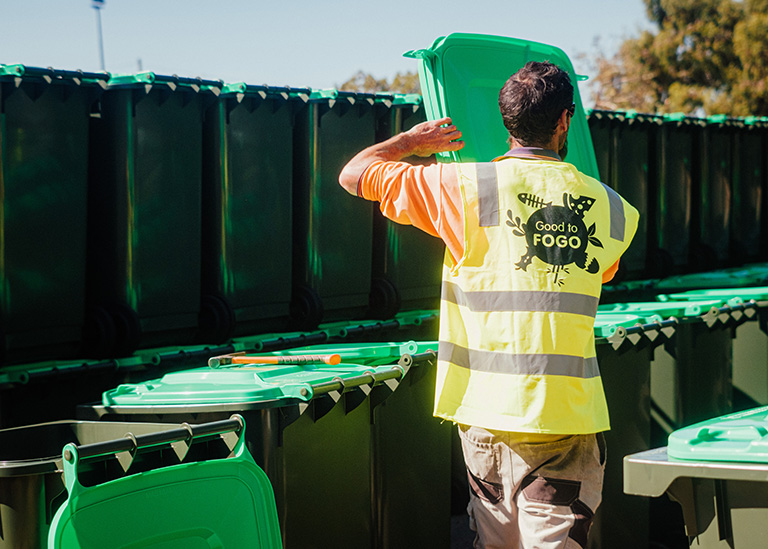
Photo courtesy City of Subiaco
Avoiding food waste
Not wasting food in the first place is the best solution to our food waste problem! Australian households can save up to $2,500 per year through meal planning, shopping for what you need, and using up leftovers. Find out how you can turn food waste around in seven steps with the national food waste avoidance campaign, The Great Unwaste.
For unavoidable food scraps, use your FOGO (Food Organics and Garden Organics) bin or try composting at home.
What is FOGO?
FOGO is the name most people will use when talking about their Food Organics and Garden Organics bin. It’s part of the three-bin system that helps West Australians get their waste sorted. Anything that used to be alive, like food scraps and garden waste, can be rescued from the general waste bin. This organic waste is then turned into compost, which can be used enrich the soil in parks, gardens and farms.
FOGO has been on the streets of WA since 2013. It goes a step further than the garden organics (or GO) bin that some people might be familiar with, which only takes grass clippings, plant cuttings, leaves, branches and other green waste from the garden.
The FOGO bin, with its lime-green lid, is supplied to residents together with a yellow-lidded recycling bin and a smaller, red-lidded bin for general waste. Most local governments also provide a kitchen caddy and some certified Australian Standard compostable caddy liners to help you sort your waste in the kitchen. The FOGO bin is typically collected each week, while recycling and general waste are collected fortnightly, on alternate weeks.
Your collected food organics and garden organics are made into high-quality compost or soil conditioner for use in the community.
Who has access to FOGO?
As at July 2025, the following local governments provide a kerbside FOGO service to their residents:
- City of Albany
- Shire of Augusta-Margaret River
- Town of Bassendean
- City of Bayswater
- City of Belmont
- City of Bunbury
- Town of Cambridge
- Shire of Capel
- Shire of Collie
- Town of Cottesloe
- Shire of Dardanup
- Shire of Donnybrook-Balingup
- Town of East Fremantle
- City of Fremantle
- Shire of Harvey
- City of Kalamunda
- City of Melville
- Town of Mosman Park
- Shire of Mundaring
- City of Nedlands
- Shire of Peppermint Grove
- City of Rockingham
- City of Subiaco
- City of Swan (parts)
- City of Vincent
So, what goes in the FOGO bin?
All of your food scraps including fruit, vegetables, eggshells, bread, dairy, meat, bones and cooked leftovers.
Outside, put grass clippings, flowers, weeds, herbs, small branches and leaves straight into the FOGO bin.
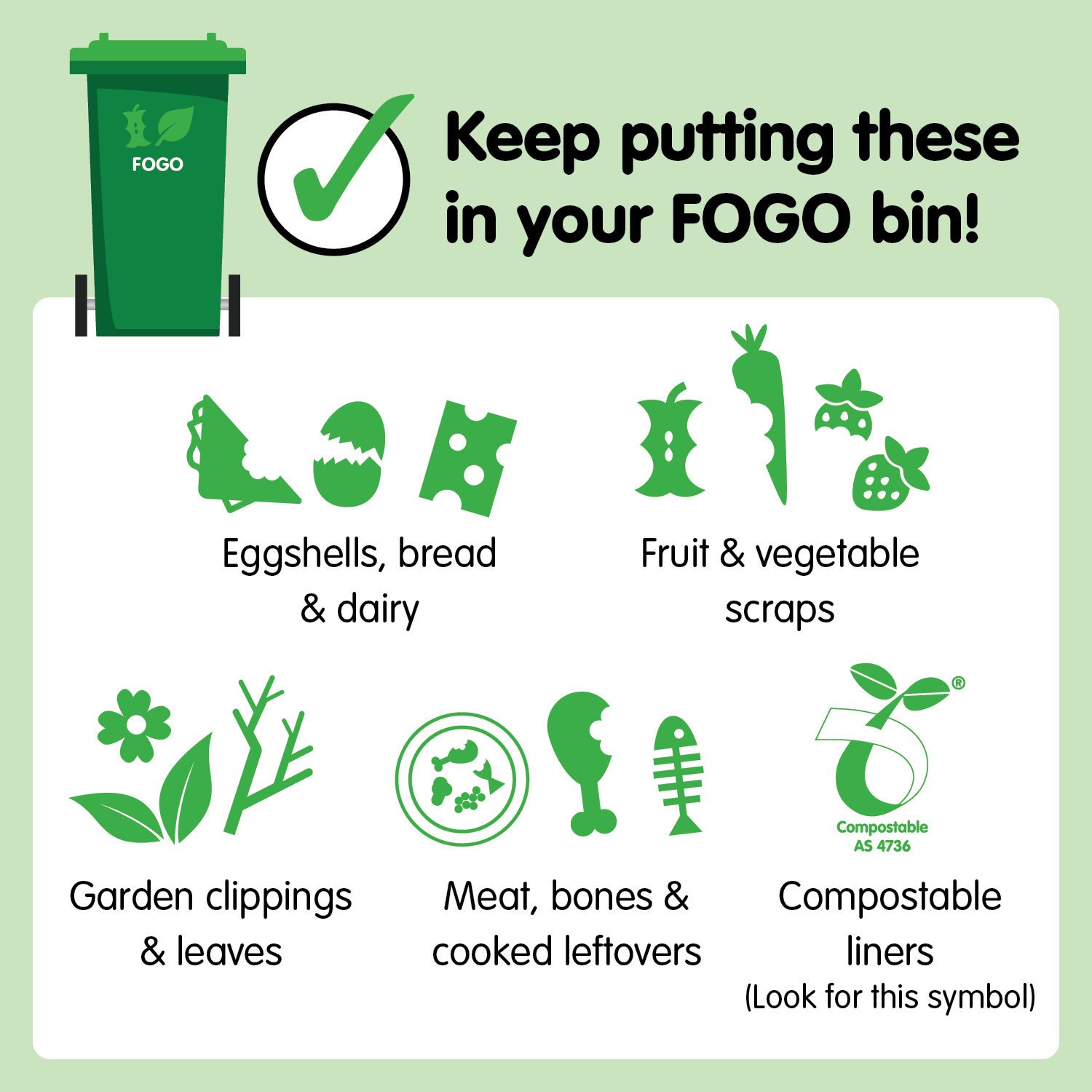
It is very important to keep all plastic, aluminium, glass and anything labelled ‘biodegradable’ out of your FOGO bin. Simply empty out packaged food into FOGO and dispose of the packaging in the appropriate bin
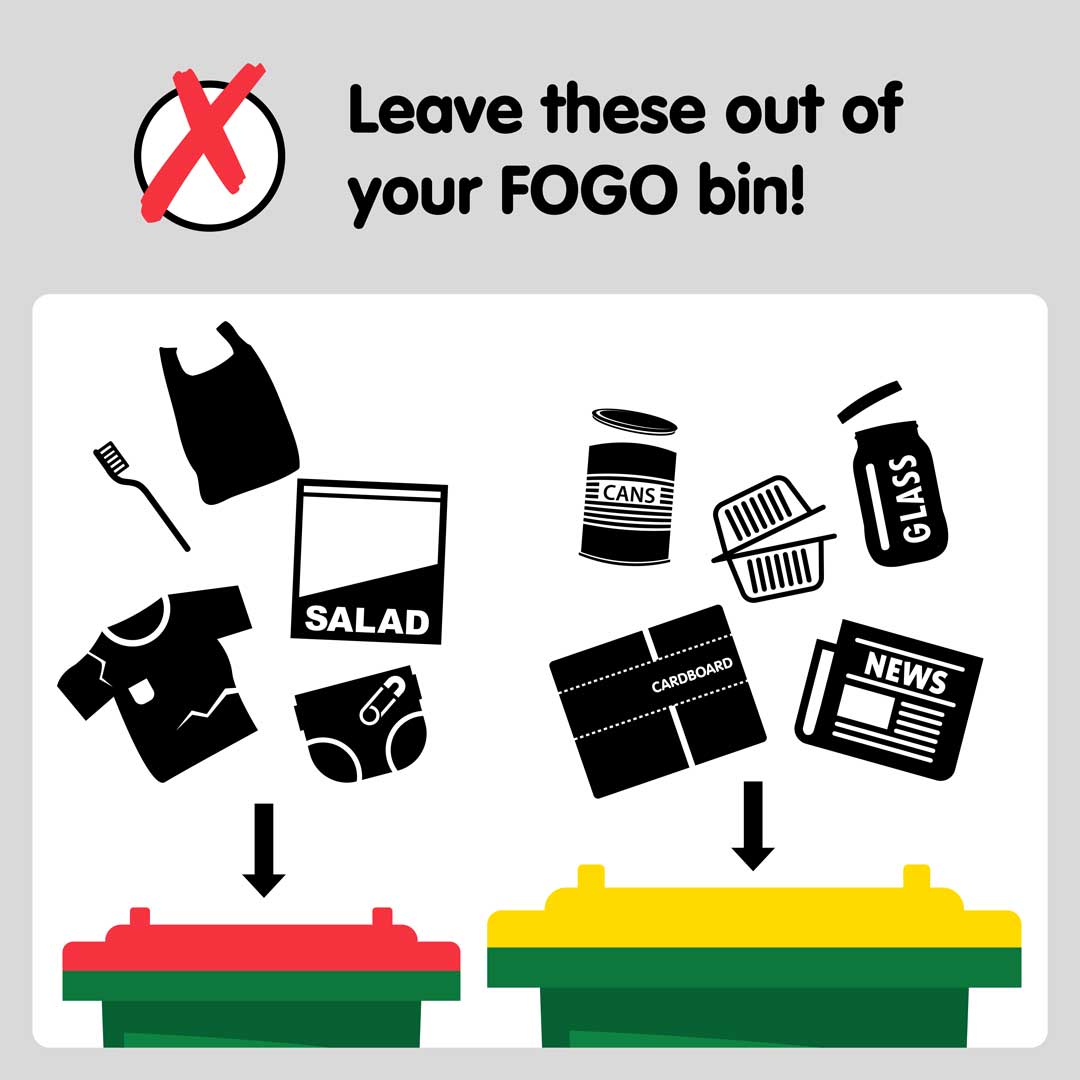
One way to think about it is: If it didn’t grow, or it wasn’t alive – it’s not FOGO.
How FOGO works
Going FOGO is easy and starts in the kitchen with setting up a kitchen caddy for collecting food scraps.
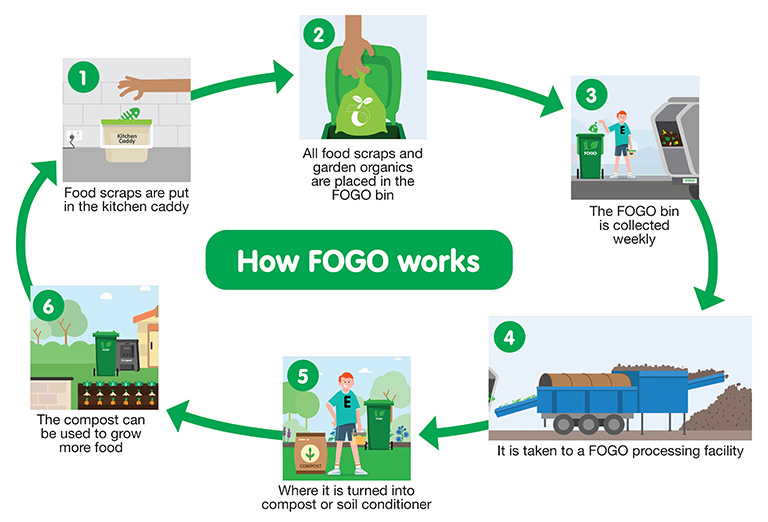
How to FOGO
What can I use as a kitchen caddy liner?
Use the compostable liners, (generally provided by your local government), to place in the kitchen caddy. Households should receive these when they get their FOGO bin.
Other options that might work for you include:
- Place items straight in and simply rinse the caddy after emptying it into the FOGO bin outside.
- Use certified compostable produce bags - remember to check for the compostable seedling logo!
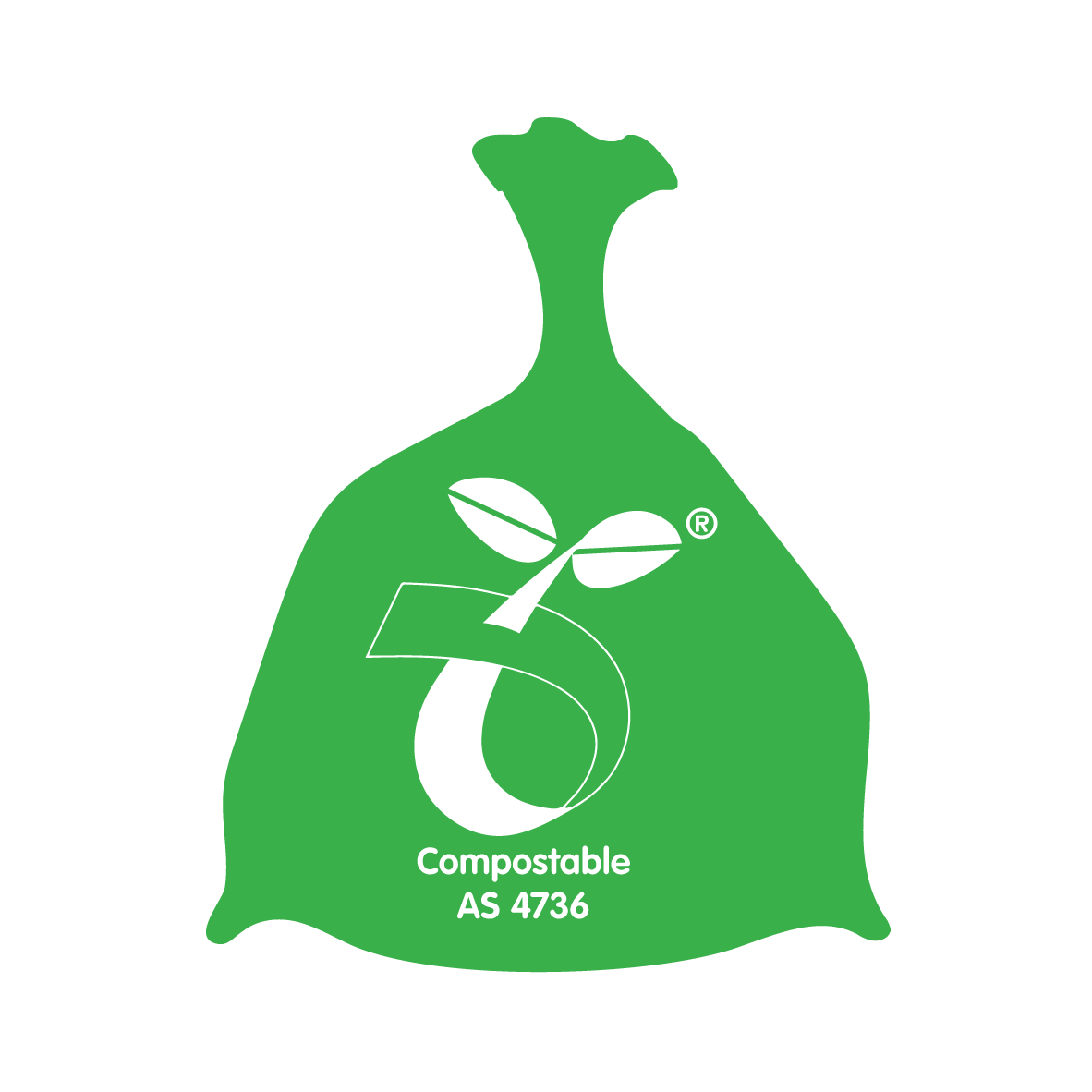
- Keep the container in the fridge or freezer until FOGO bin day to reduce odours.
- Purchase a custom container that suits your kitchen's aesthetic. Choose a size that prevents food scraps from sitting around for more than a few days.
What happens at a FOGO processing facility?
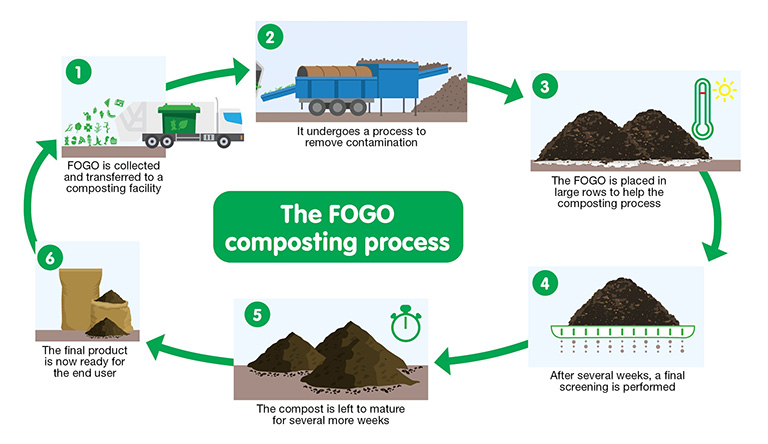
What are the benefits of FOGO-derived compost?
- Reduces amount of organic waste going to landfill
- Reduces greenhouse gas emissions
- Helps tackle climate change impacts by reducing water usage and increasing productivity of soils where used
- Compliant with Australian Standards
- Manufactured to be safe, effective, and weed-free
- Manufactured and sourced locally, supporting local jobs
Where can I buy the compost?
FOGO - derived compost is blended with other organic matter, soil components and minerals to create landscaping mixes with the right balance of nutrients, structure, drainage and pH levels for a variety of different applications.
Many FOGO local governments now stock bags of FOGO -derived compost for sale to residents. By using this compost, residents are closing the loop on their food and garden waste. Check with your local government for more information.
The below businesses stock compost and soil products made partially from FOGO waste. Stockists may change over time – please contact them prior to check if they still stock FOGO products.
Bagged suppliers – Brunnings All purpose, Garden soil and Compost
- Spudshed Locations
- Red Dot Stores
- Reject Shop Stores
- NP Supermarkets Girrawheen
- Kata n ning Hardware
- Pots WA
- Mundijong Supplies
- Mazzegas
- Madeley Pots
Bulk suppliers – Pure earth products
- Bullsbrook Landscape Supplies, Bullsbrook
- Baldivis Landscape Supplies, Baldivis
- Gidge Rural, Gidgegannup
- Green Life Soil Company, Middle Swan
- Lesmurdie Garden Supplies, Lesmurdie
- Little Loads, High Wycombe
- Instant Gardens, Upper Swan
- Maddington Landscape Supplies, Maddington
- Mundijong Garden Supplies, Mundijong
- Bali Sands, Forrestdale
- Soil World Malaga, Malaga
- Soil Your Self, Wangara
- The Landscape Yard, O ’ Connor
- Tree Aesthetics, Hazelmere
Using your FOGO compost
Check with your landscape supplier about the particular mix for accurate usage guidelines.
FOGO compost can be used as a dig-in soil conditioner to improve plant drought tolerance and soil health. I t is recommended to wear gloves and a face mask when handling compost. Please follow health warnings printed on the bag.
- Add to existing garden beds, ornamentals, veggies etc: Dig it into the top 20cm of soil. One part compost, 3 parts soil. One bag for about 1m².
- For native plants and similar: Dig it into the top 20cm of soil. One part compost, 9 parts soil. One bag for 2 –3 m².